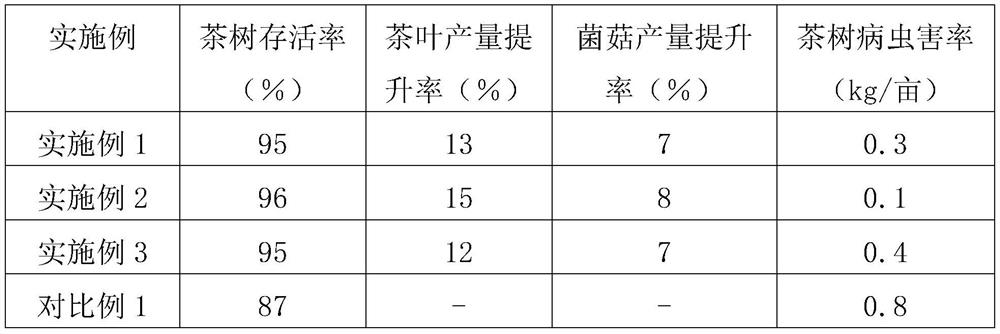Green pollution-free ecological tea planting method
An ecological planting and tea technology, applied in the direction of fertilizers made from biological waste, application, organic fertilizers, etc., can solve the problems of inability to maximize resource utilization, affect the growth of tea trees, and water loss on terraces, and achieve good sand-fixing effects. The effect of saving planting costs and reducing loss and waste
- Summary
- Abstract
- Description
- Claims
- Application Information
AI Technical Summary
Problems solved by technology
Method used
Image
Examples
Embodiment 1
[0031] A green and pollution-free tea ecological planting method comprises the following steps:
[0032] Step 1, using tea residue to prepare tea residue cellulose hydrogel and plant fiber particles;
[0033] in,
[0034] The preparation method of tea residue cellulose hydrogel is:
[0035] a) extracting tea residue, filtering, drying, removing water-soluble components, then soaking and stirring in a degreasing reagent for degreasing, washing with water, decoloring with a decolorizing reagent, washing, and drying to obtain degreasing and decolorized green tea residue;
[0036] b) uniformly mix the obtained degreasing and decolorized green tea dregs with aqueous sodium hydroxide solution, take a water bath, suction filter, and wash with water to obtain the green tea dregs after alkali extraction, carry out acidolysis, suction filtration, water washing, and bake the green tea dregs after alkali extraction dried to obtain tea residue crude fiber;
[0037] c) mixing the tea res...
Embodiment 2
[0046] A green and pollution-free tea ecological planting method comprises the following steps:
[0047] Step 1, using tea residue to prepare tea residue cellulose hydrogel and plant fiber particles;
[0048] in,
[0049] The preparation method of tea residue cellulose hydrogel is:
[0050] a) extracting tea residue, filtering, drying, removing water-soluble components, then soaking and stirring in a degreasing reagent for degreasing, washing with water, decoloring with a decolorizing reagent, washing, and drying to obtain degreasing and decolorized green tea residue;
[0051]b) uniformly mix the obtained degreasing and decolorized green tea dregs with aqueous sodium hydroxide solution, take a water bath, suction filter, and wash with water to obtain the green tea dregs after alkali extraction, carry out acidolysis, suction filtration, water washing, and bake the green tea dregs after alkali extraction dried to obtain tea residue crude fiber;
[0052] c) mixing the tea resi...
Embodiment 3
[0061] A green and pollution-free tea ecological planting method comprises the following steps:
[0062] Step 1, using tea residue to prepare tea residue cellulose hydrogel and plant fiber particles;
[0063] in,
[0064] The preparation method of tea residue cellulose hydrogel is:
[0065] a) extracting tea residue, filtering, drying, removing water-soluble components, then soaking and stirring in a degreasing reagent for degreasing, washing with water, decoloring with a decolorizing reagent, washing, and drying to obtain degreasing and decolorized green tea residue;
[0066] b) uniformly mix the obtained degreasing and decolorized green tea dregs with aqueous sodium hydroxide solution, take a water bath, suction filter, and wash with water to obtain the green tea dregs after alkali extraction, carry out acidolysis, suction filtration, water washing, and bake the green tea dregs after alkali extraction dried to obtain tea residue crude fiber;
[0067] c) mixing the tea res...
PUM
 Login to View More
Login to View More Abstract
Description
Claims
Application Information
 Login to View More
Login to View More - R&D
- Intellectual Property
- Life Sciences
- Materials
- Tech Scout
- Unparalleled Data Quality
- Higher Quality Content
- 60% Fewer Hallucinations
Browse by: Latest US Patents, China's latest patents, Technical Efficacy Thesaurus, Application Domain, Technology Topic, Popular Technical Reports.
© 2025 PatSnap. All rights reserved.Legal|Privacy policy|Modern Slavery Act Transparency Statement|Sitemap|About US| Contact US: help@patsnap.com

